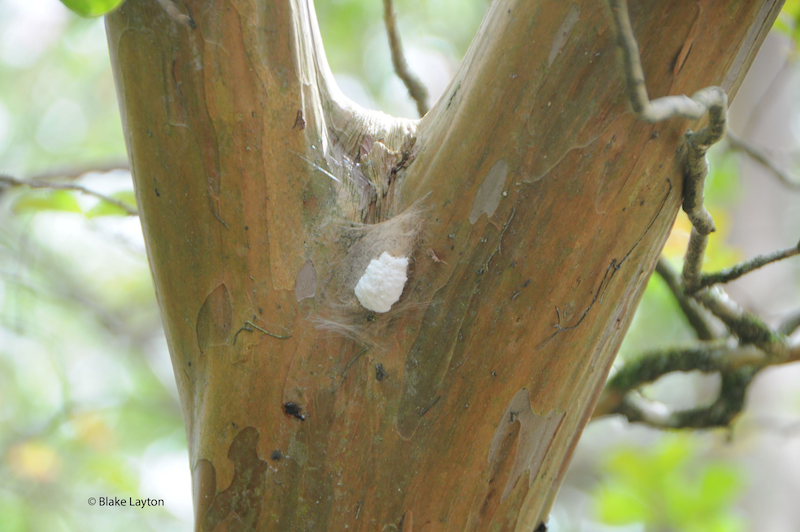White-marked Tussock Moth Eggs, Vol. 8, No. 1
Orgyia leucostigma
Order: Lepidoptera
Family: Erebidae
Spring is here and insect activity will be increasing dramatically over the next few months. But where do all these insects come from? How do they survive the winter? Insects overwinter in different ways. Some, such as polyphemus moths, overwinter as pupae in cocoons hanging from tree twigs. Monarch butterflies migrate to warmer climates and overwinter as adults, while cutworms overwinter as partly grown caterpillars. Eastern tent caterpillars spend the winter in egg masses on black cherry twigs. White-marked tussock moths also overwinter in egg masses, but like most insects, they have their own unique biological twists.
White-marked tussock moths are one of our most colorful caterpillars. Mature caterpillars are about 1.5 inches long, with pink heads and yellow stripes down their backs. The body is sparsely covered with hairs, with two long, dark tufts of hairs at the front that project forward on either side of the head, and a single long tuft of similar hairs that projects from the rear. Their most striking feature is the four dense white tufts of hair right in the center of their back that cause some people to refer to them as “toothbrush caterpillars.” These are caterpillars people notice when they see them.
They are most often seen in the fall when fully mature caterpillars are wandering about in search of a place to pupate. There have two generations per year, and are also seen earlier in the summer, but the fall generation is usually much larger. White-marked tussock moths feed on a wide range of plants but are rarely numerous enough here in the South to cause serious defoliation, and are usually not considered important plant pests, though occasionally there are local outbreaks that cause heavy defoliation.
Let one drop down the back of your shirt and wander around next to your skin for a bit, and you may well consider it a pest. Some of those hairs cause rashes and skin irritation. This is more common in children, who often can’t resist playing with such colorful caterpillars.
The caterpillars spin their relatively inconspicuous brown cocoons on the trunks of trees, and you might think they would just spend the winter there as pupae. But these moths go ahead and emerge in the fall to mate and lay eggs. The twist is that the female moths are wingless. They can’t fly anywhere, so they just sit on the cocoon from which they just emerged and emit pheromones to attract a male moth. Of course, they still can’t fly after they have mated, so they deposit their egg mass right there on top of the old cocoon, covering them with a white, protective secretion (See Photo).
The caterpillars that emerge from these eggs don’t have wings either, but they can fly—through a process called ballooning. After hatching, the caterpillars spin and hang from a silken thread, which eventually breaks and carries them on the wind, hopefully to a suitable leaf. This method of dispersal is also used by many other caterpillars, as well as by young spiderlings.
Blake Layton, Extension Entomology Specialist, Mississippi State University Extension Service.
The information given here is for educational purposes only. Always read and follow current label directions. Specific commercial products are mentioned as examples only and reference to specific products or trade names is made with the understanding that no discrimination is intended to other products that may also be suitable and appropriately labeled.
Mississippi State University is an equal opportunity institution.
Bug’s Eye View is now on Facebook. Join the Bug's Eye View Facebook group here.


